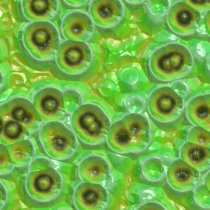How to Sketch a Microscope Slide
Identifying Cell Structures and Adding Dynamic Elements
Learning how to sketch a microscope slide requires an open-mind, patience and a willingness to learn the basic drawing principles of perspective, size, shape and negative space.
Sketching specimens will provide you with a better understanding, as you study the intricacies of the image you see through the lens – details that may be overlooked in a photo.
The Importance of a Good Sketch
Most modern microscopes are capable of employing digital image technology, but this does not make hand sketching obsolete.

For students, the simple act of drawing:
- Can help you recall specifics from a microscope lab
- Contained in a notebook, sketches provide an adjunct study aid
- Forces one to look more closely, seeing every detail
In addition, when talking to a colleague or professor and words are not providing adequate descriptions, knowing how to sketch a microscope slide will enable you to provide a visual.
Digital imaging is expensive and may not provide sufficient representations. You can create a clear and detailed sketch at any magnification, using any type of filter or condenser and with any type of microscope.
Digital images, although invaluable, may contain noise and artifacts mistaken as part of the specimen.
Talent
Anyone can learn the basics of drawing and learn how to sketch a microscope slide. Many individuals are under the misconception that you need an innate artistic talent to create a decent sketch. This is a myth.
Relax and have confidence that you have the ability to create a representational sketch. Remember, an eraser it all it takes to make improvements to your drawing.
Supplies
Drawing supplies include:
- Sheets of plain, white standard size 8½ x 11 paper
- Pencils: #2 or B soft, H fine, hard and HB medium
- Kneaded eraser
- Pens: fine and medium point, black ink
- Colored Pencils: basic 10-12 piece color set
As you gain confidence, experiment with smaller and larger size paper, different weights or consider purchasing a sketch notebook.
These supplies will provide you with the general tools to experiment. If you prefer soft graphite, purchase different ranges of B pencils. Iif you want more vibrant colors, consider oil-based colored pencils.
Where to Begin?
How to sketch a microscope slide will feel less overwhelming breaking down the drawing process.
First, to represent the microscope field of view, draw a circle on the page – this can be freehand or, if you want to be precise, use a compass.
If you are using a graticule slide (a microscope slide with millimeter grid lines), lightly sketch a grid over your circle. Alternatively, draw light lines to separate the circle into a four equal quadrants. The quadrants will help you estimate the geographic location, proportion and relative size of objects in the view field.
In addition, note the specimen, date, mounting technique, magnification and other related information in the bottom corner of your paper.
Establishing a habit of labeling your drawings while discovering how to sketch a microscope slide will enable you to keep your drawing organized.
Seeing versus Knowing
When you look at your sample, remember that the negative space or empty area is just as important as the object itself.
The negative space forces your brain to see the object as abstract, breaking down shapes more accurately.
Your brain may tell you the specimen is a rectangle with a circular nucleus, but what you actually see likely different.
The importance lies in allowing yourself the freedom to look at the specimen in an entirely new way – as if you’ve never seen it before. Learning how to observe a sample is just as important as how to sketch a microscope slide.
Once you learn to see, you can draw. Some individuals can sketch from here and others may find that it useful to associate the abstract with something familiar such as a letter or number – an abstract concept in regard to your sketch, but a reference to a form you already know how to create.
No single formula exists for everyone and experimentation is an important part in exploring how to sketch a microscope slide.
Outlines and Inner Shapes
Many individuals find it easier to begin sketching larger objects and working their way to the smaller shapes when learning how to sketch a microscope slide.

- Choose the quadrant with the largest shape in the view field; focus on the edges – are they straight or curved? Do lines intersect? Is the item contained within the quadrant or expanded onto other areas?
- Lightly map out the placement in the corresponding quarter on your paper. You can plot dots where edges change direction or sketch rough angles for placement or just sketch the outline. If you make a mistake, simply erase and redraw.
- If the shape expands over other quadrants, continue on in the same manner until the first large shape is positioned on the paper.
- Locate the next largest object; study its shape and position in reference to the first shape. Are they touching? Does one overlap the other? Closer items are always darker; but, for now, concentrate on outlining the remaining shapes.
Using the same approach, continue by sketching the inner structures.
Adding Dynamic Elements
Sketches come to life when you add highlights, shadows and color. For a pencil sketch, separate areas into white, light, medium and dark grey and black. To see the light/dark areas, squint so that the hard edges are blurred and your focus is on the shading.
Start shading the light areas by following the shapes. For example, shade vertical lines for a flat surface and curved lines for a rounded. To give emphasis to shadows you can use a crosshatch pattern, series of different size and shades of dots, parallel lines or whatever you feel best represent what you see.
Continue shading from the lightest to darkest. The darkest most detailed areas represent the objects closest to you. If you prefer to use color, rather than shading a uniform area, use the same method of light to dark.
Identification of Cell Structures
The identification of prokaryotic and eukaryotic cellular structures, shapes and organelles on accurate visual representations will make for impressive and useful sketches when learning how to sketch a microscope slide.
Lacking a membrane-nucleus, prokaryotes are simple cells identified through one of three shapes: rod, sphere and spiral. A well-drawn sketch will include the flagella, cell wall and visible organelles.
However, the most important part of the sketch is shapes indicative of specific bacteria.
With one exception, all other living cells or eukaryotes contain a membrane-bound nucleus and internal structures comprised of organelles. Plant and animal cells each contain distinguishable characteristics important to highlight in a drawing.
Thick, dark lines representing the rigid cell wall in plants will allow easy discernment from flexible animal walls.
Additional organelles, with noted characteristics, found in the cytoplasm include:
- Mitochondria
- Chloroplasts (plants)
- Endoplasmic Reticulum (ER)
- Golgi Apparatus or Complex
- Lysomes
- Ribosomes
- Cytoskeleton
- Vacuoles
To provide dynamic sketches with greater function, label these and other parts of the structures on your drawings.

Perfecting your own method of how to sketch a microscope slide will take time and practice.
Once you are comfortable with the basic concepts of creating a drawing, experiment with different size paper and drawing mediums.
More Related MicroscopeMaster Links
Check out Petri Dish with Agar - Preparation, Requirements and Procedure
|
A closer look at Diatoms |
1/ Techniques and Preparation of Microscope Slides
2/ Histology Slides - how can you, your research lab or academic institution benefit from owning a quality set?
Return from How to Sketch a Microscope Slide to Best Microscope Home
Find out how to advertise on MicroscopeMaster!




